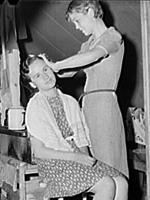
Muñoz, RicardoAboutBoyhood in the copper mining town of Santa Rita, N.M., during World War II. Discusses his work as a teacher with the Home Education Livelihood Program, a program aimed at migrant farm workers. Discusses farming families in Doña Ana County.
Abstract
Tape 1, Side A
Ricardo Muñoz, consultant, was born in Santa Rita, a copper mining camp in southwestern New Mexico. He remembers the schools built in town, a town no longer inhabited. He says that in a mine where you find copper, you will also find turquoise, silver, and gold though they just smelt out the copper at the highest temperature, and the others would be dropped to the side. When Muñoz started school in 1941, Pearl Harbor had just initiated WW II. The kids gathered metals for the war effort. At age seven he started delivering the Silver City Daily Press. When he finally gave it up in the tenth grade, he had 398 customers. After the eighth grade he went to Hurley High School, fifteen miles from Santa Rita. He graduated in 1953. He volunteered for the Marine Corps though the Korean War ended before he had to serve in Korea. He, then, played baseball for the Marines until going to Viet Nam in 1954. From there he went to Japan, and was released from the Marines in 1956. He went to Western New Mexican College and "flunked out." He says there was discrimination in his young days from the "Anglos" toward the Spanish people. Later, living in Las Cruces when it was very poor, before White Sands Missile Range was fully established in 1952, there was no discrimination but as the community got richer, more discrimination was seen, based on differences in wages, education and so forth. Muñoz returned to college (on the G.I. Bill), majoring in education, the only choice other than industrial arts. After Korea, he says, no jobs were available. After graduation he moved to Las Cruces where he couldn't find a teaching job, and worked for the highway department. In the summer of 1964, a Las Cruces minister started a federally funded program to try to help migrant workers and their children. Muñoz was hired as a teacher. They renovated a school in Vado, which is still there, and had school for the children and the adults. The adults were taught how to prepare food in an economical manner. They served children from about two years old to the fifth grade. The program was called H.E.L.P. The teachers went to where the people were working, or to their homes, and also spread the word of the school through the labor contractors. At this time some migrant workers were living in abandoned buildings. Muñoz speaks of having Vista—Volunteers in Service to America—come to the schools to talk on health care and so forth. "I would drive to pick up these volunteers and the school kids; teach math and other subjects; and take them back after school. They made a book of what we were supposed to teach in English using farm terms." The Office of Economic Opportunity funded the program and bought the books. Most of the migrants came from Texas. They were American citizens, called migrants because they followed the crop. Muñoz worked only one year for that particular program (he then went to work for the State of New Mexico Vocational Rehabilitation Division in Albuquerque). At the time of the interview the migrant school concept had been picked up by public schools. He says that a lot of migrants stayed in Las Cruces. Onions were the primary crops being grown in the valley at that time. Stahmann Farms were producing pecans; they provided housing for the workers. The onion crop was worked by the migrants. Muñoz feels that federally funded programs are weak because many political appointees, who are not necessarily educated, administer them. He speaks of some weaknesses in the Head Start program as an example. The year he worked with migrant program it was all federally funded. The school was required to have two aides from the migrant families themselves to help the teacher; therefore, he believes the children were not learning English, or how to get out of that cycle. He mentions the migrant wages in the 1960s was about $50 a day for a teenage worker. He states they also received free schooling, free medical care, and, if they choose, "decent" housing and a car. The only people in the program that were profiting from the program were the cooks who were learning to extend food, to cook differently. They would then go to the indigent people and show them how to can food and so forth. The bureaucrats also ran a sewing program even though the participants couldn't afford the fee. Muñoz is also outraged that the salary for these government workers is so high. He is against the practice of bilingual education. He remembers the flooding at Rincon, which he believes, took place in the 1930s prior to the building of Elephant Butte Dam [Elephant Butte Dam was completed on May 13, 1916]. Muñoz believes that the flood buried an entire train. He speaks of Vado families, the Boyers, who were dry farming cotton. He says the original families in Garfield are the Sanchezes, the Garcias, and the Apodacas. He speaks of what was once farmland in Las Cruces. He refers to the hermit in the Organ Mountains; and of a homeless man who was a "ghost." |

